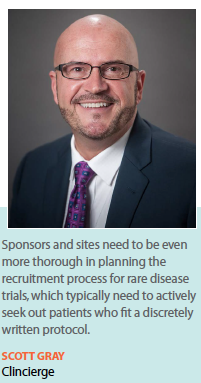 Efforts to bring treatments to market for the approximately 7,000 rare diseases affecting more than 350 million people globally have been stepped up in recent years. But in order to bring products to market, companies must conduct clinical trials with a large enough patient population — relative to the incidence of the disease — to convince regulators of the safety and efficacy of the product.
Efforts to bring treatments to market for the approximately 7,000 rare diseases affecting more than 350 million people globally have been stepped up in recent years. But in order to bring products to market, companies must conduct clinical trials with a large enough patient population — relative to the incidence of the disease — to convince regulators of the safety and efficacy of the product.
Recruitment for clinical trials is a highly complex area as it is, never mind the additional complexities involved with rare diseases.
Studies for rare diseases are not simply small common diseases studies, says Horacio Plotkin, M.D., VP and medical lead, rare disease and pediatric center of excellence, PPD.
“Companies have to make difficult decisions regarding the logistics of where sites should be engaged," he says. “Often, more sites are opened than the number of patients needed for the studies. In the case of very severe, often lethal conditions, there may not be a pool of eligible patients, but rather the study sponsor needs to wait for the patients to be diagnosed, or in some cases, be born."
“Recruitment for rare disease trials requires a significant amount of commitment to the patient population — understanding the disease and what it means to the patient and to the family to live with that disease," says Juliet Moritz, executive director for rare disease and general medicine, Premier Research. “The small size of rare disease populations makes ineffective some of the tactics used for recruitment in more common conditions."
Sarah Mandracchia, director, media and research, BBK Worldwide, says it is crucial to use creative and innovative messaging to garner the attention of rare disease patients as they interact with the various media outlets.
As much as enrollment is a crucial element, so too is patient retention. Given the high cost per rare disease patient and the fact that there are few patients available with a specific rare disease, losing a single patient can negatively affect the quality of the data gathered, says Scott Gray, CEO of Clincierge.
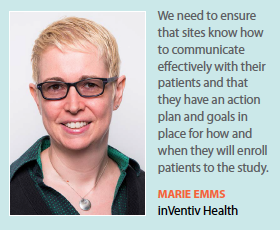 “Patient drop-outs also have a negative effect on trial cost and timelines, as they can lead to the need for trial extensions, bringing on new sites, and ultimately, delayed submissions and time to market," Mr. Gray says.
“Patient drop-outs also have a negative effect on trial cost and timelines, as they can lead to the need for trial extensions, bringing on new sites, and ultimately, delayed submissions and time to market," Mr. Gray says.
Oftentimes there are no other viable treatment options available for rare disease patients so retention may hinge on providing adequate financial, logistical, and emotional support to patients and families who are engaged in a study, says Bernadette Tosti, senior director, site and patient networks, QuintilesIMS.
To mitigate some of these issues, Thomas Schall, Ph.D., president and CEO of ChemoCentryx, which is primarily focused on orphan and rare diseases, says the company looks for clinical research centers that have experience in treating patients with the rare disease, and have had experience with clinical trials.
“We partner with CROs that have proven track records in enrolling these types of clinical trials on a global scale," he says.
Reducing the Burden
Angi Robinson, executive director for pediatrics and rare diseases, Premier Research, says to support patient identification it’s important to understand the epidemiology of the disease, including the number of patients, where they live, where they are seen, and how many other trials in that disease state are ongoing.
“Rare diseases rarely affect only the patient, so when initiating a trial in a rare indication it is also important to understand what it will mean to the patient and the family to participate, such as invasive procedures, onerous study visit schedules, and significant impact to work or school schedules," she says.
Trial designs should consider how best to mitigate the challenges participants face, such as providing patient travel support, home health, or telemedicine, Ms. Robinson notes.
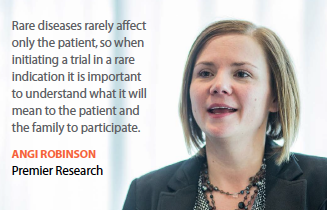 “Studies that are less burdensome on the patient/family are more likely to enroll patients and more likely to result in more patients completing the trial," she says.
“Studies that are less burdensome on the patient/family are more likely to enroll patients and more likely to result in more patients completing the trial," she says.
Dr. Schall says since some rare diseases are not easily diagnosed, the referral to a clinical trial site/specialist can sometimes take months, or even years. This means that rare disease patients are often very sick, and can suffer from medical complications that can make it difficult for them to meet the study criteria, such as regular visits to the center.
“But perhaps a bigger problem is that the tools used to measure the progression of rare diseases are often unsuited to the task," he says. “A case in point is ANCA vasculitis, where the Birmingham Vasculitis Activity Scale (BVAS) measures the patient’s symptoms rather than the patient’s sense of well-being, while our Phase III trial does measure BVAS, it also sets out to assess other relevant clinical outcomes such as faster time to remission, improved quality of life, and fewer side effects than the current standard of care."
Travel to sites can be a challenge, especially given that rare disease trials typically occur at a small number of sites. And the more rare the disease, the more dispersed the patient population is likely to be, Mr. Gray says.
“Consideration needs to be given to not only whether patients will need to travel long distances — perhaps internationally — for site visits, but how frequent those visits must be, and whether the patients have any limitations that affect their ability to travel," he says.
“Making sure that all patient needs are taken into account — for example travel, accommodations, and special needs, as well as their entertainment, comfort, fears, and concerns — will make the experience of participating in a study easier, despite the fact that we cannot offer any guarantees about the efficacy of the drug being studied," Dr. Plotkin says.
Reimbursement programs that are aimed at expediting the time it takes to reimburse patients — such as details for sites to allocate funds, real-time access to the funds by patients, and on-demand reporting for sponsors to track overall investments — allow all involved with trial participation to feel more comfortable, Ms. Mandracchia says.
According to Colin Hislop, M.D., chief medical officer, Versartis, retention in studies is generally a function of the protocol visit schedule, the number of investigations and product safety and efficacy. Versartis is developing a twice-monthly, long-acting form of growth hormone called somavaratan for the orphan disease of pediatric growth hormone 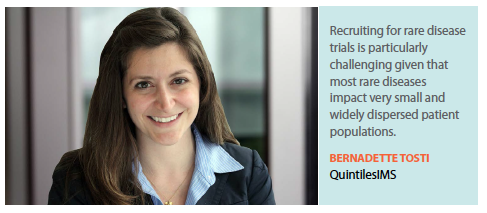 deficiency. Based on the clinical trials for somavaratan, Dr. Hislop has determined that the lesser the visit burden is the more likely patients are to remain in the study.
deficiency. Based on the clinical trials for somavaratan, Dr. Hislop has determined that the lesser the visit burden is the more likely patients are to remain in the study.
One question that often arises during trials is longer-term access to the study drug.
“This may have an impact on recruitment, particularly the early-phase studies, which are often short in duration," Ms. Robinson says. “Sponsors need to plan for prolonged access to the study drug, for example, open label extensions, etc., early on."
Sights on Sites
Companies may open dozens of trial sites that only recruit a handful of patients — if any at all — and they often spend years trying to meet minimum recruitment numbers, which is expensive, time consuming, and ultimately disappointing for patients and families anxiously awaiting new treatments to come to market, Ms. Tosti says.
When conducting feasibility for site selection, it’s important that those sites have patients already identified in the disease population, and that the sites have an understanding of where those patients are based. Understanding where their patients are located will help sites determine whether transportation is needed and what other considerations are necessary, says Marie Emms, director, global patient recruitment, inVentiv Health.
The investigator needs to be seeing and treating the patient population of interest, Dr. Hislop says.
“Taking this one step further, the protocol inclusion and exclusion criteria must reflect every day clinical practice and be representative of the type of patient clinicians see on a day-to-day basis, i.e. it must be practical and realistic and not overly academic in its requirements," Dr. Hislop says.
Working with sites to develop informed consent forms and interviewing patients on the study design are two aspects that should be included in the development of clinical trials, Ms. Mandracchia says.
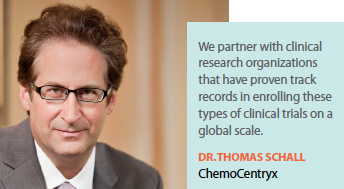 “For example, transportation may not be necessary for one, but integral for another, but the understanding of what the sites and patients will need to make that decision is the most important factor in study start up and execution," she says.
“For example, transportation may not be necessary for one, but integral for another, but the understanding of what the sites and patients will need to make that decision is the most important factor in study start up and execution," she says.
The push to ensure clinical trials enroll more diverse patient populations — in terms of sex, age, race, geographic area, and socio-economic group, combined with a focus on patient-centricity — is leading trial developers to work more closely with advocacy groups to find patients, rather than relying on local recruitment by trial sites, Mr. Gray says.
“Rather than recruit locally, patients who closely fit study requirements can be brought to a site that specializes in a given treatment regimen or patient population," he says.
While prevalence of disease and geographic distribution are important elements in managing patient recruitment, rare diseases are often misdiagnosed, so a lot of detective work often is necessary to educate healthcare professionals about the different diagnosis and patient pathways to a diagnosis, Dr. Plotkin says.
Dr. Schall says companies need to spread the net wider and conduct the trial across many more centers.
“For our Phase III ADVOCATE trial for avacopan in the treatment of ANCA vasculitis, an inflammatory disease that attacks and destroys blood vessels and then vital organs, we plan to work with close to 200 centers to enroll the 300 patients we need," he says.
Dr. Hislop agrees that a large number of sites and a longer recruitment time may be required in rare disease trials because these patients are few in number. Any restrictions in the protocol can exacerbate the difficulties. He points to the emergence of specialist CROs that focus in these areas and have significant experience.
“First-hand experience and relationship with sites is more impactful than say recruitment vendors," he says. “The latter are not really helpful in the rare disease environment."
Patient-Centric Recruitment
While in the past it was assumed patients would participate in clinical trials because there were few options open to them, the rise of patient advocacy organizations has strengthened the patient voice, Ms. Moritz says.
“Understanding the diagnostic odyssey that often precedes a rare disease diagnosis can be key," Ms. Moritz says. “Developing relationships with trusted voices in the community is also extremely important in rare disease research."
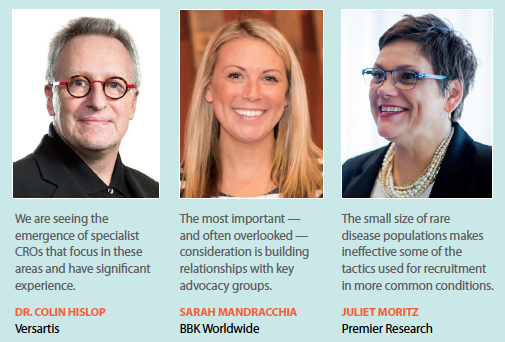 Researchers need to shift their focus and think about the trial through the eyes of the patient and their caregivers, Ms. Tosti says.
Researchers need to shift their focus and think about the trial through the eyes of the patient and their caregivers, Ms. Tosti says.
“Taking this view will help them make small changes to trial design, and avoid the mistakes that might otherwise cause them to miss out on recruiting opportunities," she says.
Advocacy groups and other trusted channels also help to ensure the patients are being spoken to in an authentic language that is meaningful to them, Ms. Emms says.
“Building relationships with advocacy groups is key to establishing trust with patients and caregivers so that we can bring them into the process earlier and also inform them of trials that are enrolling," she says.
Dr. Plotkin notes one of the hurdles sponsors of early-stage programs for rare conditions must overcome is the general distrust by the patient community of for-profit companies.
“Transparency and alliances with patient organizations are crucial," he says. “Sponsors should be ready to have in-depth discussions with the leaders of the patient organizations, who can transmit the importance and safety of a study to their constituents."
Patient focus groups also can help sponsors understand the impact trial participation may have on the lives of patients and their families, not just from a disease management perspective but the logistics of the study, Ms. Emms notes.
Where a trial is complex by necessity, reaching out to the patient and their family to explain this can be helpful, Ms. Moritz says.
When it comes to study materials it’s important to take into account the fact that rare disease patients are already very well-informed about the disease itself but at the same time ensure the study materials are written at a level they understand, Ms. Emms says.
It’s also important to remember that patients with rare diseases may either have had no treatment options before or those that exist may require improvement.
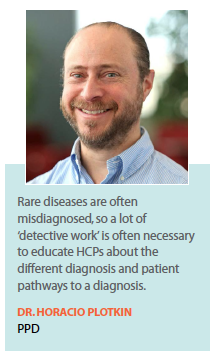 “The hope that many patients will have for a specific study or investigational drug must be balanced with how we set expectations about trial participation and what we still need to learn about a given investigational medication to determine its safety and effectiveness," Ms. Emms says.
“The hope that many patients will have for a specific study or investigational drug must be balanced with how we set expectations about trial participation and what we still need to learn about a given investigational medication to determine its safety and effectiveness," Ms. Emms says.
The perceived benefit of the therapeutic over existing treatments is the priority with recruitment and retention, followed by the credibility of the sponsor, Dr. Hislop says. That includes building relationships with treating physicians, sharing data, and contributing to the clinical knowledge by the sponsor.
“Involvement of study coordinators and study nurses who see the patients all the time makes a critical difference too," he adds.
According to Ms. Mandracchia, although the execution in terms of which tactics to run advertisements on or which retention programs to put in place for a muscular dystrophy vs. a diabetes study will be drastically different, the approach of managing each study should be identical.
“At the core of clinical trial execution, regardless of condition or therapeutic area, are programs and initiatives that are built on site- and patient-centricity," she says.
Technological advances are helping to reduce the burden on patients and their family, such as in-home assessments, sample collection and telemedicine, which permit the patient to remain in their home, Ms. Moritz says.
“Even complex assessments, such as spirometry for pulmonary function testing, are now able to be completed in the home," she says.
“Technologies that permit remote consent or facilitate assessing a patient or caregiver’s understanding of the informed consent for a trial also increase retention."
An app that stores all pertinent study information — details on study visit procedures, dates, and times of their study visits linked to the native calendar on their app for reminders and alerts, e-brochures, and informational packets to inform them of trial participation, and even a site contacts page so that they can be one click away from calling or emailing any of their site staff members — can help to keep the study top of mind as patients interact with their phones daily while providing the necessary educational materials for patients to understand all that is involved with their participation, Ms. Mandracchia says.
She adds that over the next five to 10 years, the clinical trial community needs to continue to innovate and adopt new ideas, technologies, and programs that reach the right patients faster and more efficiently. (PV)
~~~~~~~~~~~~~~~~~~~~~~~~~
Social Forums in Rare Disease Trial Recruitment
The landscape for patient recruitment has changed dramatically over the last few years and continues to evolve steadily.
“New social networks have made way for new advertising platforms and ways to connect with potential patients such as Instagram and Snapchat," says Sarah Mandracchia, director, media and research, BBK Worldwide. “In addition to new platforms, many patients are using multiple devices — mobile and desktop. Some of the most impactful trend shifts within our industry are apps and virtual trials."
And those living with rare disease have quickly become sophisticated healthcare consumers in the digital age.
“We have worked on many rare and orphan trials in which we have leveraged social listening to support the overall recruitment strategy, including trial messaging and outreach methods," says Bernadette Tosti, senior director, site and patient networks, QuintilesIMS.
“Understanding the conversations that patients are having regarding a particular disease, as well as knowing the top websites that patients are viewing, helps us in the development of messages and images that would resonate with patients."
Conversations taking place on the forums of key patient advocacy groups can help CROs identify which groups have patients who would have potential interest in a trial, as well as identifying potential key opinion leaders to network with experts who can provide assistance in recruiting efforts, Ms. Tosti adds.
“In a recent example of using data and analytics for better recruitment, we were engaged on a study for a rare, neurological disorder where recruitment had been slower than expected with patients concentrated in a relatively small number of institutions," she says. “By leveraging de-identified patient data, we were able to develop a ‘heat map’ of diagnosed patients by treatment center. Using this approach, we prioritized physician referral sources and re-engaged QuintilesIMS’ investigators with a high patient potential. Using this method of evaluating treatment patterns will help us better inform site and recruitment strategies for rare disease trials, and clinical studies in other indications, in the future."
Greater access to information combined with more research and development into medicines that help fight rare diseases has made it easier to recruit patients for clinical trials, which in turn helps to speed up development of promising drug candidates, says Thomas Schall, Ph.D., president and CEO of ChemoCentryx.
There are, however, ramifications from the rise of digital communications, for example that trial participants may want to share experiences online about their participation and potentially ‘compare notes’ about how they feel.
“We have a responsibility to educate trial participants about the potential impact on study results should they discuss their experiences while enrolled," says Marie Emms, director, global patient recruitment, inVentiv Health.



















